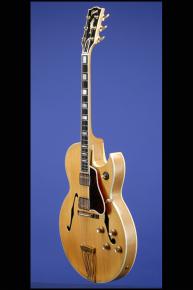One of the Most Beautiful Guitars Ever Made
This top-of-the-line 17-inch-wide thinbody (2 1/4 inches deep) guitar weighs in at just 6.80 lbs. and has a nut width of just under 1 11/16 inches and a short scale length of 23 1/2 inches. Carved spruce top reinforced with two parallel braces, solid 'lightly-flamed' maple back and sides, five-piece maple/mahogany/maple/mahogany/maple neck with a very comfortable medium profile and 22 wide jumbo frets. Ebony fretboard with pointed end and inlaid pearl block position markers. Nine-ply binding on the top of the guitar, five-ply binding on the back, five-ply binding on the headstock, three-ply binding on the fretboard plus two white lines on either side, and single-bound f-holes. Headstock with seventeen degree peghead angle and inlaid pearl "Gibson" logo and pearl flowerpot ("torch") inlay. Two-layer (black on white) truss-rod cover with "Custom" engraved in white. Black-painted headstock rear face. Serial number ("62382") impressed into the back of the headstock. Individual Kluson Sealfast tuners with tulip-shaped metal buttons. Orange oval label inside the bass f-hole with the style ("Byrdland") and serial number ("62382") written in black ink. Two great-sounding "patent-number" humbucker pickups with black plastic surrounds and perfectly balanced outputs of 7.69k and 7.70k. Each pickup with a black label ("Patent No. 2,737,842") on the underside. Tortoiseshell pickguard with five-layer (white/black/white/black/white) plastic binding. Four controls (two volume, two tone) on lower treble bout, plus three-way pickup selector switch on upper treble horn. Gold plastic bell-shaped knobs with metal tops. ABR-1 non-retainer Tune-O-Matic retainer bridge with nylon saddles on rosewood base and specific three-loop tailpiece with "Byrdland" engraved on the cross-bar. All hardware gold-plated. This guitar, in near mint (9.25) condition, is one of the nicest-playing and best-sounding Byrdlands that we have ever seen. The back of the guitar has some beautiful 'birds-eye' figuring and the back of the neck is slightly flamed. There is the bare minimum of finish checking to the body - otherwise this fine forty-five year old blond beauty is almost as newr. Housed in its original Gibson black hardshell case with four latches and orange plush lining (9.25). This is one of only thirty-two Florentine Cutaway Natural Byrdlands shipped in 1963, out of a total production run of just 129 guitars between late 1960 and 1968.
"Named after famed 50s guitarists Billy BYRD and Hank GARLAND, the [$550.00] Byrdland was unveiled in 1955 as the top-end model in the then new thinline series. Patterned after the L-5CES, save for a shorter and narrower neck [designed for easier fingering of 'twisted' chords and faster playing speed], the Byrdland went through the same evolution in terms of pickups and body style. Three main variants can be successively distinguished up to 1965...The first variant of the Byrdland [with a round Venetian cutaway] is characterized by its Alnico pickups with six individually adjustable rectangular magnet poles...In early 1958 the Alnico pickups were replaced by humbuckers. All the other specifications remained unchanged...In late 1960 the body was restyled with a pointed Florentine cutaway to facilitate access to the fingerboard. The newer shape entailed the use of a slightly shorter pickguard. All the other specifications remained unchanged. Subsequently, the neck was changed from a 2-piece to a 3-piece maple lamination for added strength in mid-62. About a year later, the Byrdland was no longer systematically built with a solid 2-piece maple back and one-piece laminated maple backs were brought in. The round Venetian cutaway was eventually reinstated on the Byrdland in early 1969" (A.R. Duchossoir, Gibson Electrics -- The Classic Years, pp. 220-221).
"Jazz players at the time were experimenting with chords that required great stretches of the left hand, and the Byrdland was designed to accommodate them with a shorter, 23 1/2-inch scale and a narrow neck. Otherwise it was essentially a thinbodied L-5CES" (George Gruhn and Walter Carter, Electric Guitars and Basses: A Photographic History, p. 203).
The Byrdland is undoubtedly one of the most beautiful guitars ever made.
Translate:









